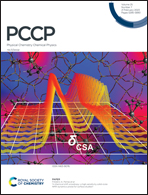Shedding light on the physical nature of ion pair interactions involving carba-closo-dodecaborate anions. Insights from computation†
Abstract
closo-Carboranes are structures that have been studied for many decades due to their vast applicability in medicine, catalysis, and energy storage. In order to go deeper into the physics behind the interactions of oppositely charged ions, which have potential applications in electrical energy storage and conversion devices, the present work aims to shed light on the physical nature of the interactions involving (R–CB11H11−, R = H, F, CH3, CF3) and Mq+ = Li+, Na+, Mg2+, Zn2+ ions. The bonding situations are evaluated in light of both canonical Kohn–Sham energy decomposition, EDA-NOCV, and local energy decomposition, LED, analyses. Electron and hole transports are also evaluated through charge transfer integrals. The findings reveal that such complexes present not only more significant electrostatic, but also non-negligible orbital contributions. Both energy decomposition analyses EDA-NOCV and DLPNO-LED confirm that the strength of ionic pair interactions (R–CB11H11− ↔ Mq+) is much more dependent on the nature of the cation employed than on the substituent R used. The results also reveal that charge transfers are not significant in such interacting systems.



 Please wait while we load your content...
Please wait while we load your content...